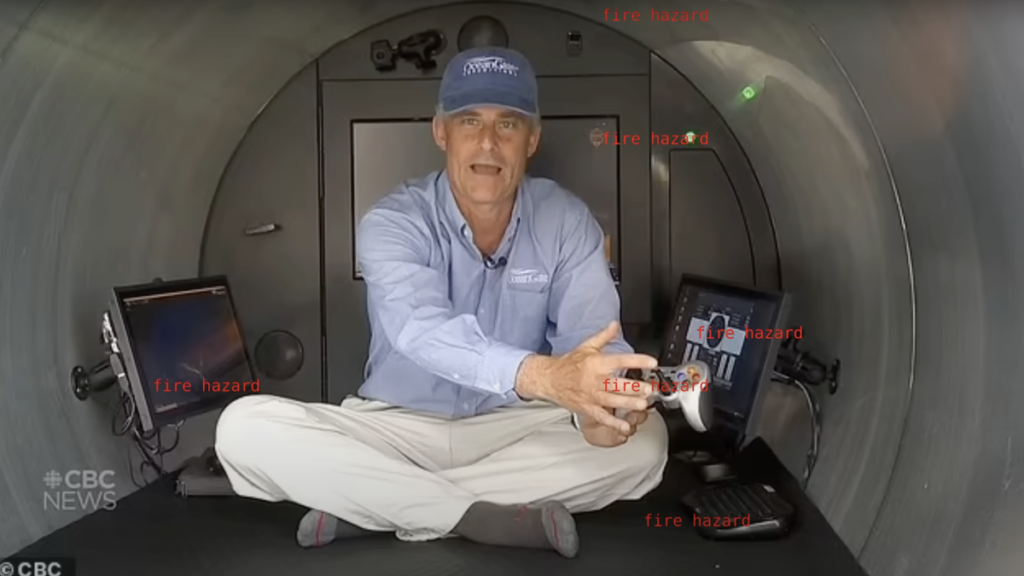The Titan Submersible Was Designed And Built Even Worse Than You Think

Sure, we’ve all read about the wireless game controller and lights from Camping World being used in the construction of the Titan, the Titanic-touring submersible which suffered a catastrophic implosion last week, but those issues are just scratching the surface of what’s wrong when it comes to the design and build quality of the vessel.
OceanGate CEO Stockton Rush’s ability to convince people his sub was safe was disarming, even “predatory” as a friend of Titan victim Paul-Henri Nargeolet told Insider. But all the buzzwords in the world couldn’t cover some basic fatal design flaws. Let’s start with one of the most fundamental; its shape. According to the Associated Press:
While OceanGate Expeditions, which owned and operated the craft, touted the Titan’s roomier cylinder-shaped cabin made of a carbon-fiber, industry experts say it was a departure from the sphere-shaped cabins made of titanium used by most submersibles.
A sphere is a “perfect shape” because water pressure is exerted equally on all areas, said Chris Roman, a professor at the University of Rhode Island’s Graduate School of Oceanography.
The 22-foot long (6.7-meter long), 23,000-pound (10,432-kilogram) Titan’s larger internal volume — while still cramped with a maximum of five seated people — meant it was subjected to more external pressure.
The shape isn’t the only place Rush went wrong. This fascinating video from an engineer with experience in testing vessels in deep-sea environments breaks down the countless number of things that could have gone wrong on the submersible. While the entire setup seems a little sus to a laywoman like me, all of the issues YouTuber Just Alex dives into must have given anyone with actual technical knowledge of these vessels heart attacks:
Oceangate Titan: analysis of an insultingly predictable failure
Much has been made about the Titan’s untested carbon fiber hull, for instance. Carbon fiber is famously strong, until it experiences damage and strain. There’s a reason most deep sea vessels are made with steel or titanium (and most car-bodies are not) because those metals are homogeneous when properly manufactured, meaning less potential for a point of failure. Carbon fiber, however, is more inhomogeneous as the material is made with woven strands and epoxy. Once in operation, it would need to be checked closely for wear and tear, which Rush said was impossible to do.
But it’s not just that single dicey material; the video points out that the way the carbon fiber tube was attached to two hemispheres made of titanium may not have been optimal. OceanGate affixed the two materials using epoxy. While Alex thinks this is probably the only way to do it, this presents a new set of challenges, and a new point of failure. The epoxy holding the carbon fiber to the titanium would have been put under two different kinds of stress from the two different materials. This, Rush also said was impossible to inspect, though X-Ray could be used to look for cracks or failure points. He points out that, in a video posted by OceanGate showing the application of the epoxy, the job was done pretty sloppily as well. From the video:
For such a critical installation, I’d expect a dust-free environment, maybe even temperature controlled with stringent handling procedures and a vacuum degasser for the resin. I see none of that in this video. It was performed in an open warehouse.
Rush also said there was no way to monitor this epoxy for degradation, which begs the question; if there’s no way to make sure this sub is safe, then why was it built this way?
And that’s not even the problem that horrifies Alex the most. He points out every piece of off-the-shelf electronics in the Titan created unacceptable fire risks, that the lack of passenger restraints were dangerous for both pilot and passengers, and all of the exposed tubing on the outside of the craft all could lead to disaster. And that’s not taking into account the depth-worthiness of the viewing port only being certified at a depth of 1,300 meters while routinely sinking to 4,000 meters, as NPR reports.
The entire video is fantastic breakdown of how small technical glitches can have huge impacts.







